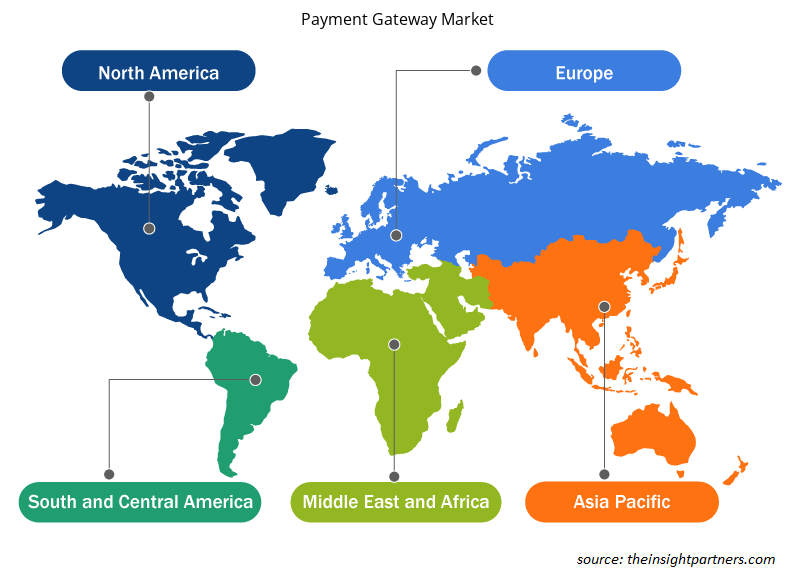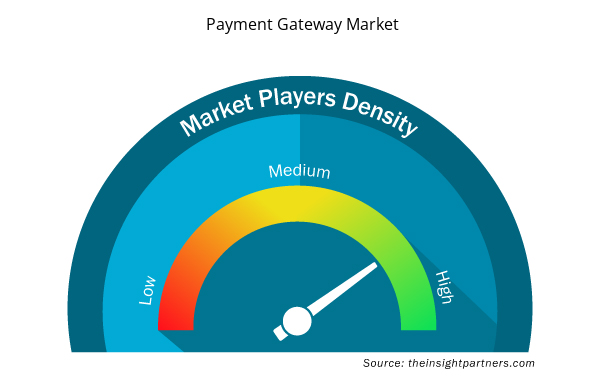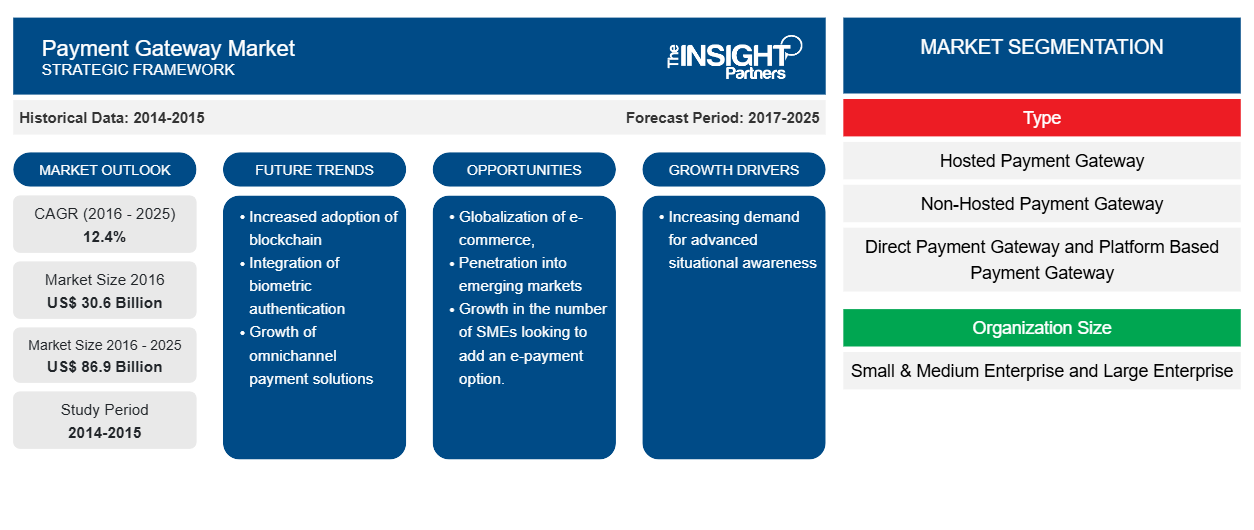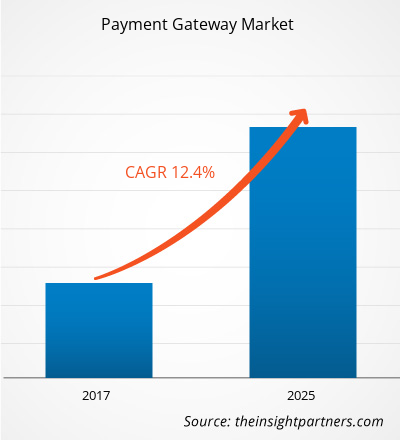Si prevede che il mercato globale dei gateway di pagamento crescerà da 30,6 miliardi di dollari nel 2016 a 86,9 miliardi di dollari entro il 2025, con un CAGR del 12,4% tra il 2017 e il 2025.
I commercianti di tutto il mondo sono desiderosi di espandere le loro attività oltre confine adattando un approccio logico, collaborando con i gateway di pagamento. Con l'aiuto di questa partnership, questi commercianti ottengono il vantaggio di sfruttare le opportunità create dalla globalizzazione dell'e-commerce. La maggior parte dei commercianti oggi sta tenendo d'occhio l'espansione globale e desidera crescere a un ritmo più veloce, tuttavia, l'ultima cosa di cui avrebbero mai bisogno in questo panorama dinamico e competitivo è un gateway di pagamento che o frena la loro crescita o li spinge a collaborare con più PSP (Payment Service Provider) in diverse regioni. Per affrontare questi problemi, il settore dei pagamenti sta invitando i progressi tecnologici, aprendo la strada alla crescita del mercato dei gateway di pagamento
Personalizza questo report in base alle tue esigenze
Riceverai la personalizzazione gratuita di qualsiasi report, comprese parti di questo report, o analisi a livello nazionale, pacchetto dati Excel, oltre a usufruire di grandi offerte e sconti per start-up e università
- Scopri le principali tendenze di mercato in questo rapporto.Questo campione GRATUITO includerà analisi di dati che spaziano dalle tendenze di mercato alle stime e alle previsioni.
Il rapporto si concentra su una segmentazione approfondita di questo mercato in base al tipo e al settore delle dimensioni dell'organizzazione. La segmentazione geografica del rapporto copre sei regioni principali tra cui: Nord America, Europa, Asia-Pacifico (APAC), Medio Oriente e Africa (MEA) e Sud America (SA). Il mercato regionale è stato ulteriormente suddiviso in base ai rispettivi paesi. In base al segmento delle dimensioni dell'organizzazione, le grandi imprese hanno rappresentato la quota maggiore del mercato dei gateway di pagamento nel 2016; mentre, si prevede che la regione del Medio Oriente e dell'Africa crescerà al CAGR più elevato durante il periodo di previsione. Il rapporto mira a fornire una panoramica del mercato globale dei gateway di pagamento con una segmentazione di mercato dettagliata. Inoltre, analizza l'attuale scenario del mercato dei gateway di pagamento e prevede il mercato fino al 2025. Il rapporto copre le dinamiche di mercato che influenzano il mercato durante il periodo di previsione. Inoltre, il rapporto analizza lo scenario competitivo, le tendenze geografiche e le opportunità nei mercati rispetto a tutte le regioni geografiche. Il rapporto include anche i profili aziendali dettagliati dei principali attori del mercato insieme alle loro strategie di mercato. Il rapporto fornisce anche un'analisi PEST di tutte e cinque le regioni, insieme all'analisi SWOT per tutte le aziende descritte nel rapporto.APAC), Middle East and Africa (MEA) and South America (SA). The regional market has been further bifurcated by respective countries. By organization size segment large enterprises accounted for the largest share of the payment gateway market in 2016; whereas, Middle East & Africa region is expected to grow at the highest CAGR during the forecast period.
Approfondimenti regionali sul mercato dei gateway di pagamento
Le tendenze regionali e i fattori che influenzano il Payment Gateway Market durante il periodo di previsione sono stati ampiamente spiegati dagli analisti di Insight Partners. Questa sezione discute anche i segmenti e la geografia del Payment Gateway Market in Nord America, Europa, Asia Pacifico, Medio Oriente e Africa, e Sud e Centro America.

- Ottieni i dati specifici regionali per il mercato dei gateway di pagamento
Ambito del rapporto sul mercato dei gateway di pagamento
| Attributo del report | Dettagli |
|---|---|
| Dimensioni del mercato nel 2016 | 30,6 miliardi di dollari USA |
| Dimensioni del mercato entro il 2025 | 86,9 miliardi di dollari USA |
| CAGR globale (2016-2025) | 12,4% |
| Dati storici | 2014-2015 |
| Periodo di previsione | 2017-2025 |
| Segmenti coperti | Per tipo
|
| Regioni e Paesi coperti | America del Nord
|
| Leader di mercato e profili aziendali chiave |
|
Densità degli attori del mercato: comprendere il suo impatto sulle dinamiche aziendali
Il mercato del Payment Gateway Market sta crescendo rapidamente, spinto dalla crescente domanda degli utenti finali dovuta a fattori quali l'evoluzione delle preferenze dei consumatori, i progressi tecnologici e una maggiore consapevolezza dei vantaggi del prodotto. Con l'aumento della domanda, le aziende stanno ampliando le loro offerte, innovando per soddisfare le esigenze dei consumatori e capitalizzando sulle tendenze emergenti, il che alimenta ulteriormente la crescita del mercato.
La densità degli operatori di mercato si riferisce alla distribuzione di aziende o società che operano in un particolare mercato o settore. Indica quanti concorrenti (operatori di mercato) sono presenti in un dato spazio di mercato in relazione alle sue dimensioni o al valore di mercato totale.
Le principali aziende che operano nel mercato dei gateway di pagamento sono:
- PayPal Holdings, Inc.
- Pagamenti Amazon, Inc.
- Trading sicuro limitato
- Società limitata
- Società a responsabilità limitata
Disclaimer : le aziende elencate sopra non sono classificate secondo un ordine particolare.

- Ottieni una panoramica dei principali attori del mercato dei gateway di pagamento
Il Nord America è una delle regioni più importanti nel mercato dei gateway di pagamento che contribuirà ai ricavi più elevati a livello globale grazie agli sviluppi tecnologici e alla notevole applicazione del gateway di pagamento in diversi segmenti di utenti finali. Le economie in rapida crescita nell'area Asia-Pacifico (APAC) con una crescita significativa del settore delle costruzioni apriranno la strada a una maggiore adozione e spingeranno il mercato per il mercato dei gateway di pagamento. Si prevede che la regione APAC guiderà il mercato con il CAGR più elevato durante il periodo di previsione. Alcuni dei principali attori del mercato dei gateway di pagamento includono PayPal Holdings, Inc., Amazon Payments, Inc., Secure Trading Limited, Cardstream Limited, CCBill, LLC, BitPay, Inc., GoCardless Ltd., Stripe Inc., Due Inc. Merchant Warrior, Authorize.Net e WePay Inc. tra gli altri.
- Analisi storica (2 anni), anno base, previsione (7 anni) con CAGR
- Analisi PEST e SWOT
- Valore/volume delle dimensioni del mercato - Globale, regionale, nazionale
- Industria e panorama competitivo
- Set di dati Excel


- Lymphedema Treatment Market
- Saudi Arabia Drywall Panels Market
- Smart Mining Market
- Medical Audiometer Devices Market
- Single-Use Negative Pressure Wound Therapy Devices Market
- Electronic Toll Collection System Market
- Parking Management Market
- Redistribution Layer Material Market
- Neurovascular Devices Market
- Vision Care Market

Report Coverage
Revenue forecast, Company Analysis, Industry landscape, Growth factors, and Trends

Segment Covered
This text is related
to segments covered.

Regional Scope
North America, Europe, Asia Pacific, Middle East & Africa, South & Central America

Country Scope
This text is related
to country scope.
Trends and growth analysis reports related to Banking, Financial Services, and Insurance : READ MORE..
The List of Companies
1. PayPal Holdings, Inc.
2. Amazon Payments, Inc.
3. Secure Trading Limited
4. Cardstream Limited
5. CCBill, LLC
6. BitPay, Inc.
7. GoCardless Ltd.
8. Stripe Inc.
9. Due Inc.
10. Merchant Warrior
11. Authorize.Net.
12. WePay Inc.
The Insight Partners performs research in 4 major stages: Data Collection & Secondary Research, Primary Research, Data Analysis and Data Triangulation & Final Review.
- Data Collection and Secondary Research:
As a market research and consulting firm operating from a decade, we have published and advised several client across the globe. First step for any study will start with an assessment of currently available data and insights from existing reports. Further, historical and current market information is collected from Investor Presentations, Annual Reports, SEC Filings, etc., and other information related to company’s performance and market positioning are gathered from Paid Databases (Factiva, Hoovers, and Reuters) and various other publications available in public domain.
Several associations trade associates, technical forums, institutes, societies and organization are accessed to gain technical as well as market related insights through their publications such as research papers, blogs and press releases related to the studies are referred to get cues about the market. Further, white papers, journals, magazines, and other news articles published in last 3 years are scrutinized and analyzed to understand the current market trends.
- Primary Research:
The primarily interview analysis comprise of data obtained from industry participants interview and answers to survey questions gathered by in-house primary team.
For primary research, interviews are conducted with industry experts/CEOs/Marketing Managers/VPs/Subject Matter Experts from both demand and supply side to get a 360-degree view of the market. The primary team conducts several interviews based on the complexity of the markets to understand the various market trends and dynamics which makes research more credible and precise.
A typical research interview fulfils the following functions:
- Provides first-hand information on the market size, market trends, growth trends, competitive landscape, and outlook
- Validates and strengthens in-house secondary research findings
- Develops the analysis team’s expertise and market understanding
Primary research involves email interactions and telephone interviews for each market, category, segment, and sub-segment across geographies. The participants who typically take part in such a process include, but are not limited to:
- Industry participants: VPs, business development managers, market intelligence managers and national sales managers
- Outside experts: Valuation experts, research analysts and key opinion leaders specializing in the electronics and semiconductor industry.
Below is the breakup of our primary respondents by company, designation, and region:

Once we receive the confirmation from primary research sources or primary respondents, we finalize the base year market estimation and forecast the data as per the macroeconomic and microeconomic factors assessed during data collection.
- Data Analysis:
Once data is validated through both secondary as well as primary respondents, we finalize the market estimations by hypothesis formulation and factor analysis at regional and country level.
- Macro-Economic Factor Analysis:
We analyse macroeconomic indicators such the gross domestic product (GDP), increase in the demand for goods and services across industries, technological advancement, regional economic growth, governmental policies, the influence of COVID-19, PEST analysis, and other aspects. This analysis aids in setting benchmarks for various nations/regions and approximating market splits. Additionally, the general trend of the aforementioned components aid in determining the market's development possibilities.
- Country Level Data:
Various factors that are especially aligned to the country are taken into account to determine the market size for a certain area and country, including the presence of vendors, such as headquarters and offices, the country's GDP, demand patterns, and industry growth. To comprehend the market dynamics for the nation, a number of growth variables, inhibitors, application areas, and current market trends are researched. The aforementioned elements aid in determining the country's overall market's growth potential.
- Company Profile:
The “Table of Contents” is formulated by listing and analyzing more than 25 - 30 companies operating in the market ecosystem across geographies. However, we profile only 10 companies as a standard practice in our syndicate reports. These 10 companies comprise leading, emerging, and regional players. Nonetheless, our analysis is not restricted to the 10 listed companies, we also analyze other companies present in the market to develop a holistic view and understand the prevailing trends. The “Company Profiles” section in the report covers key facts, business description, products & services, financial information, SWOT analysis, and key developments. The financial information presented is extracted from the annual reports and official documents of the publicly listed companies. Upon collecting the information for the sections of respective companies, we verify them via various primary sources and then compile the data in respective company profiles. The company level information helps us in deriving the base number as well as in forecasting the market size.
- Developing Base Number:
Aggregation of sales statistics (2020-2022) and macro-economic factor, and other secondary and primary research insights are utilized to arrive at base number and related market shares for 2022. The data gaps are identified in this step and relevant market data is analyzed, collected from paid primary interviews or databases. On finalizing the base year market size, forecasts are developed on the basis of macro-economic, industry and market growth factors and company level analysis.
- Data Triangulation and Final Review:
The market findings and base year market size calculations are validated from supply as well as demand side. Demand side validations are based on macro-economic factor analysis and benchmarks for respective regions and countries. In case of supply side validations, revenues of major companies are estimated (in case not available) based on industry benchmark, approximate number of employees, product portfolio, and primary interviews revenues are gathered. Further revenue from target product/service segment is assessed to avoid overshooting of market statistics. In case of heavy deviations between supply and demand side values, all thes steps are repeated to achieve synchronization.
We follow an iterative model, wherein we share our research findings with Subject Matter Experts (SME’s) and Key Opinion Leaders (KOLs) until consensus view of the market is not formulated – this model negates any drastic deviation in the opinions of experts. Only validated and universally acceptable research findings are quoted in our reports.
We have important check points that we use to validate our research findings – which we call – data triangulation, where we validate the information, we generate from secondary sources with primary interviews and then we re-validate with our internal data bases and Subject matter experts. This comprehensive model enables us to deliver high quality, reliable data in shortest possible time.


 Ottieni un campione gratuito per questo repot
Ottieni un campione gratuito per questo repot